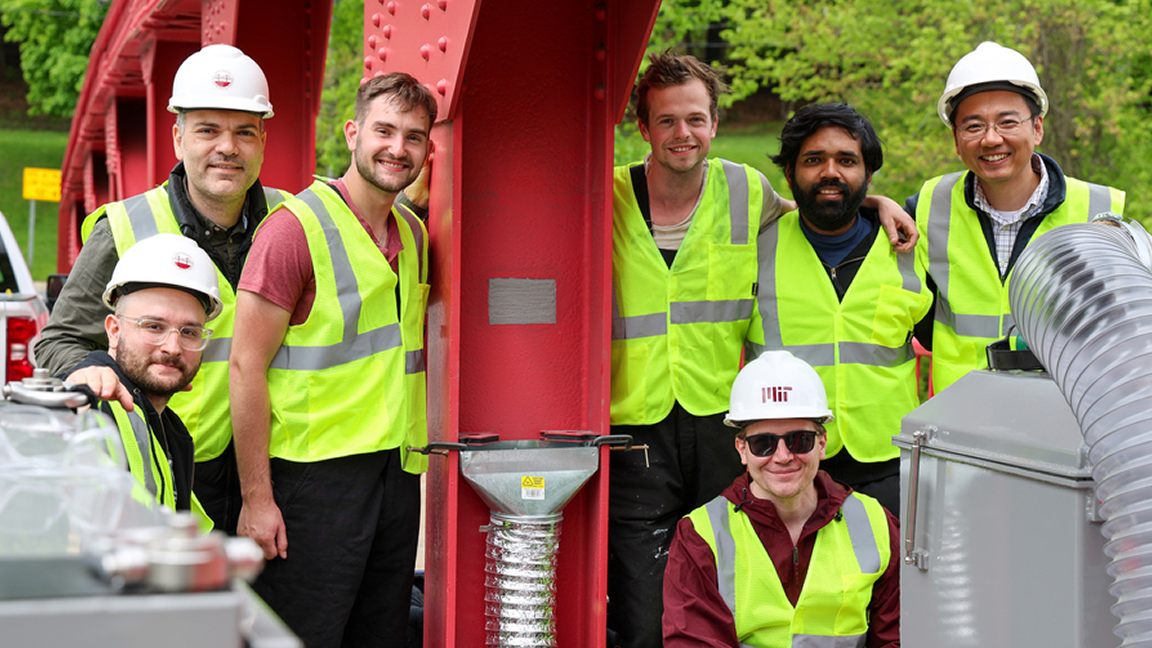MIT researchers repair bridges by 3D printing steel onto corroded beams — Tech uses compressed gas to heat and accelerate powdered steel particles

It looks like the world of 3D printing is continuing to expand its spaghetti-like branches into the field of construction. It wasn't long ago when we covered the world's tallest 3D printed building, but the project we have to share today is more on the repair and restoration side. Rather than produce a new structure, the University of Massachusetts at Amherst has been working with researchers at MIT to develop a bridge repair process involving a 3D printing technique called cold spray.
Cold Spray is a 3D printing technique designed to add new deposits of steel to existing beams. Corroded beams are potential candidates for this additive treatment. However, this is still in early development. The process is being applied to real bridges but will need to be evaluated once they're replaced to see how well the structures held up to use.
Cold Spray process uses powdered steel
A post recently shared to the MIT website details some of the Cold Spray process, explaining that it uses compressed gas to heat and accelerate powdered steel particles. It needs to be applied manually by a technician who builds up the steel layer by layer. This continues until the beam reaches the desired size.
The team found a bridge in Great Barrington, Massachusetts on track to be demolished within the next few years. This caught the researchers' eye as it provides them a chance to test the durability of their creation on a corroded section of the bridge. Once the bridge is taken down, the researchers can check to see if the corrosion has stopped or worsened after the Cold Spray addition.
The cold spray technique has been used to repair a handful of other things, as well, like submarines, ships and even airplanes — pretty much anything you can manufacture from steel. What makes this cold spray project unique is that it's pretty difficult to move a bridge, especially one that's in use. That said, if you've got a goal in mind, it helps to have the best 3D printer on hand for the project. To solve the problem, the team created a cold spray system that could be brought to the bridges to do the repairs.
This technology is still in its early stages, so it's hard to tell how effective it might be at providing sound structure for bridge beams. Until then, we can stand aside and appreciate the effort and its impressive nature.
Follow Tom's Hardware on Google News to get our up-to-date news, analysis, and reviews in your feeds. Make sure to click the Follow button.
Get Tom's Hardware's best news and in-depth reviews, straight to your inbox.

Ash Hill is a contributing writer for Tom's Hardware with a wealth of experience in the hobby electronics, 3D printing and PCs. She manages the Pi projects of the month and much of our daily Raspberry Pi reporting while also finding the best coupons and deals on all tech.
-
phead128 Why not invest in proper infrastructure instead of slapping unproven bandaid solutions that likely won't last long term.Reply -
USAFRet Reply
Well, yes.phead128 said:Why not invest in proper infrastructure instead of slapping unproven bandaid solutions that likely won't last long term.
Go back 50 years, and build the bridge differently from the beginning.
Meanwhile, this procedure is being tested on a bridge that will be replaced anyway:
"The team found a bridge in Great Barrington, Massachusetts on track to be demolished within the next few years. This caught the researchers' eye as it provides them a chance to test the durability of their creation on a corroded section of the bridge. Once the bridge is taken down, the researchers can check to see if the corrosion has stopped or worsened after the Cold Spray addition." -
Mr Majestyk Reply
You'll have to ask your local politician I guess.phead128 said:Why not invest in proper infrastructure instead of slapping unproven bandaid solutions that likely won't last long term. -
BFG-9000 I don't see how this can be easier than removing a beam and replacing it on a bridge.Reply
Thing is, we've already had something similar since the 1960s in spray-transfer GMAW and this looks like it requires much larger and bulkier equipment. The problem with either is you are paying someone to slowly apply metal (as in "a technician uses an applicator to spray the steel onto the beam") as well as someone to keep checking to see if every spot is thick enough. If you unbolt a beam and replace it with one with well known properties then it's as good as new, but if you spray metal all over the joints then in the future you will have no option but to cut out the beam and weld in a replacement with all the required X-Ray weld inspections and stuff later. So it would make repairing the bridge so much more expensive that you would practically have to replace it instead.
I can imagine some applications where you would not want to remove the beam such as if they are tunnel reinforcement ribs and you can't access the back side, especially if you did not care about how much bulk or weight is added. -
phead128 Reply
"Bridge Maintenance" does not sound as sexy as a couple daisy cutters and bunker busters.Mr Majestyk said:You'll have to ask your local politician I guess. -
chemistu This has nothing to do with 3D printing. Cold spray as a method for deposition and coating has been around for longer than 3D printers have.Reply -
BFG-9000 Well those "3D Printing Pens" are essentially like glorified hot glue guns for you to squirt piles of plastic goo by hand with, so I suppose they could be considered manual 3D printing.Reply
Like how a lathe or mill would be manual without the CNC part to run programmed operations with. -
edzieba Reply
Bingo. Cold-spray is old, flame-spray is older still (predating most of the bridges that could be repaired).chemistu said:This has nothing to do with 3D printing. Cold spray as a method for deposition and coating has been around for longer than 3D printers have.
The actually important bit of this study is validating that prior coupon testing (that showed cold-spray would be used for an adequate repair) could also scale to real-world repairs. This takes use of cold-spray from "yes, that could in theory work" to "we can start using this in actual repairs".
When was the last time you tried removing a girder from a bridge whilst leaving the bridge standing? Bear in mind that if you need to repair one structural member, then it's likely any surrounding members would be in a similar state of repair so either cannot support the now increased load with their now-reduced margins, or you now need to go one-at-a-time removing a member and repairing and replacing it before moving onto the next, keeping the bridge closed for years during the process. That's assuming you can even get a structural engineer to sign off on cutting out a corroded member supported only by a reduced number of compromised corroded members (with estimated-at-best response to the both increased load and change in load application, e/g/. new torsion components) in the first place.BFG-9000 said:I don't see how this can be easier than removing a beam and replacing it on a bridge.
Or, repair the members in place and only need to close for the duration of the spraying operations. And with only additive process in use without the need to remove any members, the modelling work required beforehand is far reduced, as is risk.
The advantages on repair-in-place are starkly obvious. -
phead128 this is the engineering equivalent of the "landlord special" of painting over rust spots on a wall, except on critical decaying infrastructure. But no worries, "3D printed metal additive" makes it a novel tech.Reply -
ZuliMuli Leave it to MIT students to just learn about spray welding... It's only been a thing for 100 years. I worked at a shop that had WW2 machine that did the cold spray with powder just like they are doing it.Reply